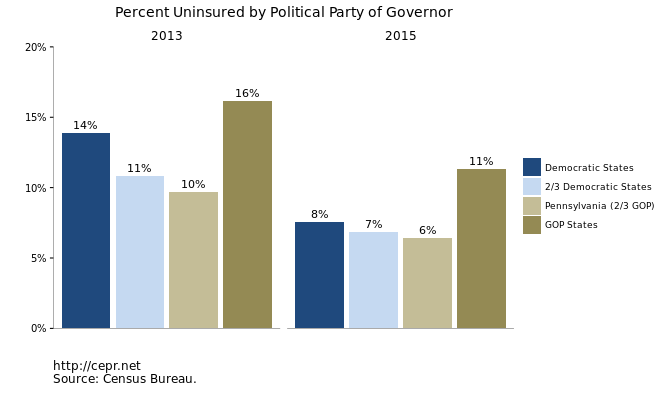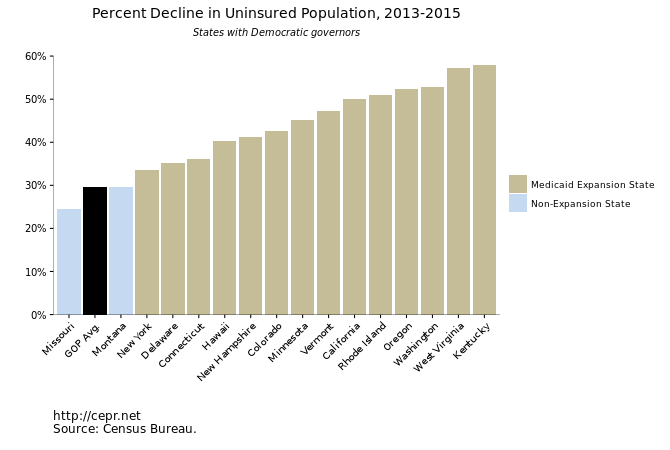September 30, 2016
Since the main provisions of the Affordable Care Act (ACA) were implemented in 2014, the uninsured rate has declined precipitously. This was on full display in the Census Bureau’s 2015 health insurance report, which showed that the share of Americans lacking coverage declined 5.1 percentage points between 2013 and 2015. According to the data from the American Community Survey (ACS), the share of the population without insurance fell from 14.5 to 9.4 percent (pp. 24-25).
Due to its large sample size, the ACS allows us to look at the change in the uninsured rate at the state level. And when looking at the state-by-state data, a clear pattern emerges: states with Democratic governors have seen far more significant gains in coverage than states with Republican ones.
To illustrate this point, Figure 1 below shows the 2013 and 2015 uninsurance rates for four groups of states: those which had a Democratic governor in 2013, 2014, and 2015; states which had a Democratic governor for two out of the three years; Pennsylvania, the only one state which had a Republican governor two of three years; and states which had a Republican governor all three years. The drop in the uninsurance rate has been greatest in the Democratic states.

Using the same breakdowns, Figure 2 shows declines in the uninsured population according to the political affiliation of the governor. Democratic states have managed to reduce their uninsured populations by over 45 percent, which is 1.5 times the reduction in Republican states.

If the decline in Republican states had matched the decline in Democratic states, an additional 4.2 million Americans would have health insurance. The 2015 uninsurance rate in the 28 Republican states would’ve been 8.8 percent rather than 11.4 percent.
What drives this discrepancy? It’s partially that Democratic governors have been better about expanding their states’ insurance exchanges so as to get more people enrolled in private plans. This is especially true of Kentucky, which has experienced a 58 percent drop in its uninsured population, the largest in the country.
However, the main difference between the Democratic and Republican states is that the Democratic states were far more likely to expand access to Medicaid. Of the 16 Democratic states in our sample, 14 chose to expand the program; just eight of the 28 Republican states did the same.
Figure 3 shows that the few Republican states which did expand access to Medicaid had the largest declines in their uninsured populations. Seven of the eight Republican states with the largest declines accepted the Medicaid expansion; of other 20 states with smaller declines, 19 rejected it. Figure 3 also includes the average decline in uninsurance across the 16 Democratic states; notably, not a single Republican state had as large a decline as the average Democratic state.

Figure 4 reproduces the results from Figure 3 but looks at Democratic rather than Republican states. The two Democratic states which chose not to expand Medicaid – Missouri and Montana, which saw 25 and 30 percent drops in their uninsured populations, respectively – experienced declines that were similar to those of Republican states which chose not to expand. However, the Democratic states on average saw much larger decreases than the Republican states for two reasons. First, Democratic states which expanded access to Medicaid saw greater coverage gains than Republican states which did the same. Michigan, the Republican state with the single largest drop, saw its uninsured population fall 44.5 percent. Over half (eight out of 14) of the Democratic states expanding Medicaid beat that mark. Six Democratic states – California, Rhode Island, Oregon, Washington, West Virginia, and Kentucky – saw declines of 50 percent or more.
The second (and more important) factor has already been mentioned – Democratic governors were more likely than their Republican counterparts to expand Medicaid. This can be seen by the discrepancy in the number of blue versus brown bars in each graph.

The Affordable Care Act, on the whole, has been tremendously successful in reducing the ranks of the uninsured. However, the reductions have been far less significant under Republican governors than under Democratic ones. Ensuring that the poor have access to medical care is evidently a partisan issue.






